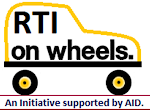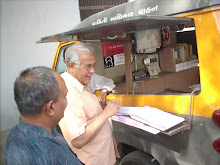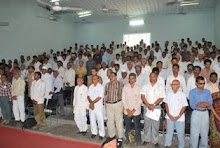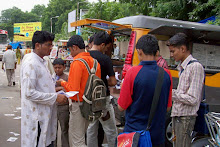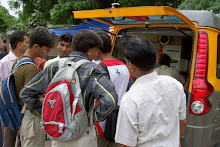GlobalPost: New Delhi: Tuesday,
February 05, 2013.
Over
the past five years, some 150 whistleblowers have allegedly been harassed or
jailed for exposing corruption. As many as 20 have been killed.
 |
| A free-speech activist in New Delhi on Aug. 16, 2011 |
In India, the
truth might set you free. Or it might land you behind bars. Or even dead.
Take the case
of Naveen Sorinjee, a TV reporter jailed in Karnataka for exposing an assault
on young couples by a far-right Hindu group. Sorinjee has inspired a hunger
strike and a slew of editorials. But more than a two months after his arrest,
he's still in the slammer. And he's not alone.
India this
year plunged to its lowest ranking on Reporters Without Borders' world press
freedom index since 2002, falling to 140 out of 179 countries, as governments
around the country cracked down on free speech and allowed criminals, political
“workers” and armed groups to attack journalists with impunity.
Meanwhile,
since the right to information law gave rise to the anti-corruption movement,
the number of bureaucrats, activists, and even policemen who were harassed,
beaten, jailed and murdered for daring to expose government and corporate
malfeasance has continued to grow, according to the Asia Center for Human
Rights (ACHR).
Though
they're rarely considered together, India's crackdown on free speech and its
assault on muckraking activists are both part of an escalating war on
whistleblowers that is intended to squash any objection to the near-absolute
power of the state.
Over the past
five years, some 150 whistleblowers have allegedly been harassed or jailed for
exposing corruption, while as many as 20 have been killed.
The latest
trend: State and local governments are exploiting India's notoriously slow
court system to land activists behind bars or saddle them with criminal charges
that may take decades to resolve.
Even the
national government has joined the fray, going after aid groups that receive
international funding in a smear campaign intended to discredit them as
anti-national and then starve them of cash.
“The
government is absolutely complicit in these activities,” said ACHR's director
Suhas Chakma. “Without the cooperation of the local authorities, these cases
can never be done. In some cases you will see the complicity even of the
judiciary.”
A reporter
for a local channel called Kasturi Newz24, Sorinjee ran afoul of the
authorities in Karnataka after a report on an incident in July in which members
of a far-right group called the Hindu Jagarana Vedike allegedly attacked and
beat up several young men and women for daring to attend a birthday party unchaperoned.
Though he'd
exposed the incident one of a string of alleged assaults perpetrated by
far-right groups in Mangalore in the name of moral policing Sorinjee was
charged with participating in it.
According to
India's Hindu newspaper, in November he was arrested and charged with “rioting
with deadly weapons,” criminal conspiracy, unlawful assembly, and using
criminal force on a woman with the intention of outraging her modesty, in
Indian legal-speak. Citing the obvious video evidence, Sorinjee and his
supporters say those were the activities his news report depicted not anything
he did himself.
In January, a
group of reporters, editors and activists held a three-day hunger strike to
highlight Sorinjee's plight. But nearly a month later, he's still languishing
in jail. And even if Twitter rumors that the authorities are poised to drop the
charges against him prove true, he will have spent nearly a quarter of the year
behind bars. And, again due to the glacial pace of India's legal system, he will
have virtually no recourse to the law for compensation for false arrest.
The case is
not unique to Mangalore, to Karnataka, or to the Hindu right.
“It happens
all over the country,” said Chakma. “It can happen anywhere, any day.”
So it
seems, according to a random sampling.
In August
2011, 35-year-old activist Shehla Mahsood who'd filed countless
right-to-information applications and leveled allegations of corruption against
local politicians associated with illegal diamond mining was shot dead on her
way to an anti-corruption protest in Madhya Pradesh.
In February
2012, 42-year-old Premnath Jha, who'd filed right-to-information applications
regarding several construction projects in Maharashtra, was gunned down while
riding home on his motorcycle.
In Gujarat in
2009, 50-year-old Purshottam Chauhan, who'd sought information about a costly
project that the local village council had purportedly undertaken with
government funds, was badly beaten by a gang of thugs.
Meanwhile, in
October 2011 in Haryana, journalist Ramesh Singla, who'd been writing articles
about the illegal mining business in the state, was killed in a suspected hit
and run. And in September 2011, cub reporter Lingaram Kodopi, a member of one
of Chhattisgarh's indigenous tribes, was arrested as a so-called middleman
between nefarious activists and the Maoist rebels waging a simmering
insurrection in his troubled home state.
And the
list goes on.
The catalyst
for these false (or dubious) prosecutions, assaults and murders was the passage
of the groundbreaking Right to Information Act (RTI) in 2005.
By giving
ordinary citizens the right to access virtually any government document, the
law cracked open a tortuous, bureaucratic system that had been a virtual black
box since the days of India's colonization. It made refusal to divulge
information a jailable offense. And, even if it did not result in a rash of
convictions, it began to make the corrupt nexus among politicians, career
bureaucrats and corporations politically untenable.
Now that
nexus is striking back not only against right-to-information activists, but
against all forms of scrutiny and dissent.
Cartoonist
Aseem Trivedi, novelist-turned-activist Arundhati Roy and Kashmiri separatist
leader Syed Ali Shah Geelani, among others, have been charged with sedition for
political speech that authorities deemed to be “anti-India.”
Right-wing
gadflies have reported mysterious server failures for their Twitter accounts
and blogs, following a government crackdown that was supposedly limited to the
suppression of specific offensive or inflammatory images.
Anybody with
something to say, it seems, is an enemy of the state.




